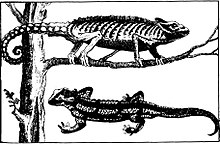Madagascar (1609)
The book Madagascar published by Hieronymus Megiser in 1609 is one of the earliest printed descriptions of the island of Madagascar . The full title is
"Truthful / thorough and detailed, if so historical as a chorographic description of the exceedingly rich / powerful and far-reaching island of MADAGASCAR, otherwise referred to as S. LAVRENTII / which today is considered the greatest on the sea / in the whole perimeter of the world. Sampt telling of all the same qualities and opportunities / inhabitants / animals, fruits and earthen plants. Also of all the stories / as they were before and since they were invented / have happened. Also discussed dictionario and dialogues of the Madagascar language. Everything drawn together with special diligence from Portuguese / Italian and Latin / also other languages Historicis and Geographis / translated into German / and decorated with nice copper pieces. "
In addition to a description of the island, the work contains the first Malagasy - German dictionary as an appendix .
content

The text is divided into ten chapters. It is preceded by a detailed dedication to Duke Johann Philipp von Sachsen-Altenburg on his twelfth birthday.
The first chapter contains a summary of ancient to medieval passages that were interpreted as mentions of the island of Madagascar in Megiser's time. This chapter is followed by a geographical outline of the location and size of the island, the port cities, bays and offshore islands in the scope of two chapters. The fourth chapter describes the inhabitants and their social structures as well as language and customs. In chapters five to seven, fauna, flora and the ambergris , which at the time was still unexplained in its origin, especially washed up in northern Madagascar , are described as important export items. In addition to some incorrect information, e.g. B. the claims there are elephants and giraffes on the island, also a copper plate with a very early representation of a chameleon . The last three chapters deal with historical events; the eighth chapter with the history of the Malagasy people, chapters nine and ten with the voyages of the Portuguese and Dutch explorers. The appendix consists of an 82-page dictionary of the Malagasy language and a short phrasebook with useful phrases for seafarers to negotiate with the local population. Many Malagasy words come from local dialects on the east coast.
History of the plant
Around 1600 Megiser toured northern Germany, England and the Netherlands, where he was given access to reports from Dutch captains who first visited the island of Madagascar in 1595 and came into contact with its inhabitants on the East India Route. Megiser was appointed to Leipzig by Elector Christian II in 1603 as an associate professor and historiographer from the Electorate of Saxony ; he held this position until 1612. During this time, the young Johann-Philipp, who later became Duke of Saxony-Altenburg, grew up at the court of Christian II. He was considered educated and interested in many things. Megiser dedicated his work to him, which is dated January 1, 1609 and was published by Henning Grosse in Altenburg . The number of copies is unknown and today the book is only in four German public libraries ( Lower Saxony State and University Library Göttingen , City Archives and Scientific City Library Soest , University Library Tübingen and the Württemberg State Library Stuttgart ). A second edition appeared in Leipzig in 1623.
The first translation into English was in 1877 by the Reverend James Sibree (1836–1929), who was a missionary in Madagascar.
In April 1883 a Malagasy delegation was in Germany and received two copies of the book from Carl Alexander , Duke of Saxe-Weimar-Eisenach, as a gift for Queen Ranavalona II . After Madagascar was conquered by France in 1895, one of these specimens came into the hands of the French naturalist Alfred Grandidier , who translated it into French in 1903 . The underlying original copy is still in the Grandidier Fund in Antananarivo today .
In 1997, with the help of the German embassy in Antananarivo, a facsimile edition was published with the revised French translation Grandidiers and, for the first time, a Malagasy translation. This version contains a detailed introduction in three languages, which describes the background to the creation of the work and its edition history.
expenditure
- Hieronymus Megiser: True […] description of the […] Insul MADAGASCAR […] . 179 p., 5 sheets of register, 8 copper engravings, Verlag Henning Grosse d. J., Altenburg 1609.
- Hieronymus Megiser: True […] description of the […] Insul MADAGASCAR […] . 2nd edition, Leipzig 1623.
- Hieronymus Megiser and James Sibree: An ancient account of Madagascar. AD 1609. Translated from the German ... Description of the mighty ... Island Madagascar. With introductory notice by J. Sibree . Friends' Foreign Mission Association, Antananarivo 1877.
- Alfred and Guillaume Grandidier: Collection des ouvrages anciens concernant Madagascar: ouvrages ou extraits d'ouvrages. Volume 1: 1500-1613 . Comité de Madagascar, Paris 1903.
- Hieronymus Megiser: True […] description of the […] Insul MADAGASCAR […] . Facsimile of the 1609 edition with French and Malagasy translations by Beby Soa Raminosoa Ramaharo and Suzy Rajaonarivo. Société Malgache d'Edition, Antananarivo 1997. ISBN 2-911477-03-0
literature
- Dagmar Bechtloff: Introduction . In: Hieronymus Megiser: Truthful […] description of the […] Insul MADAGASCAR […] . Pp. I-XV, Société Malgache d'Edition, Antananarivo 1997. ISBN 2-911477-03-0
Web links
Online edition of the ULB Saxony-Anhalt , accessed on September 15, 2010